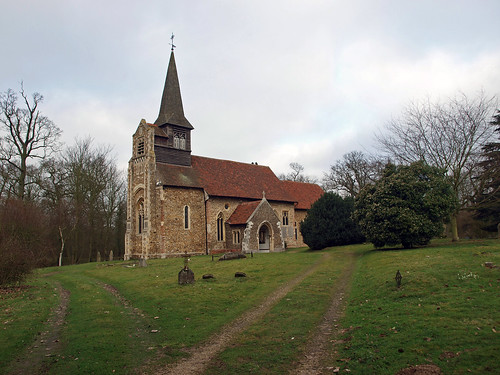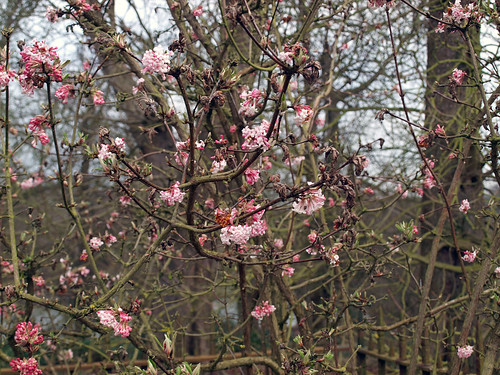A strange thing is happening - I'm beginning to appreciate the Chelmsford style, if the location also appeals which in this case it did. Sadly, but understandably, the church is locked although I would have thought that with a commercial wedding venue only a few hundred yards away somehow a keyholder could be inveigled.
No matter, I suspect the interior would have disappointed. Incidentally if you're a fisher or twitcher this area of Essex abounds with possibilities.
ALL SAINTS. A picturesque setting of the first order, with the large serpentine lake and the generous trees of the grounds of Braxted Park as a background to the little church, which is itself also picturesque. The best view is from the W, with the C13 tower with W buttresses and a bellcote of 1883 (?), behind which appears the timber belfry stage of the tower with two-light windows. Were the recent additions designed by the Rev. E. Geldart, rector of Little Braxted? Of the C13 a S and a N lancet and the tower arch towards the nave without any break between jambs and voussoirs. The rest of the church principally Norman, see one N window of the nave and one of the chancel. The chancel was originally apsed. Its present E end is C13 and has lancet windows, at the E end a group of three single ones stepped. The S porch is C15 with a timber-roof on carved corbels. - PANELLING. In the chancel, early C17, not originally in the church. - STAINED GLASS. Window of N transept above the Du Cane vault 1844 by Warrington. - PLATE. Cup of 1562, Paten also Elizabethan; Almsdish of 1646; Flagon of 1660; Paten of 1711. - MONUMENT. Robert Aylett d. 1654. Inscription tablet, and l. and r. of it two tablets with shields and two roundels with skulls, bones and a shovel (under the tower).
On these hills lived the Romans, and the Normans used their bricks to shape the windows of the church. The lancets in the chancel and in the walls under the wooden turret were added in the 13th century; one of them has a medieval sundial scratched on it. The roof of the 15th century porch has timbering resting on stone corbels, two angels and two human folk.
Simon K -
"Forgive me, aren't we talking rather loud?
I think I see a woman praying over there."
" Praying? The service is all over now
And here's the verger waiting to turn out
The lights and lock the church up. She cannot
Be Loyal Church of England. "
- John Betjeman, from Bristol and Clifton
Braxted Hall is a vast 18th Century estate whose village is Great Braxted, smaller than its Little namesake and a good three miles from it.
Climbing up the hill I came to a pair of gates, recently unlocked but with a lock and chain at the ready, and a driveway which led after about a quarter of a mile to the church. I followed a car up the drive, assuming they had just unlocked the gates for the day, and I had arrived at a good time. But by the time I got to the end of the long drive, they had locked themselves into the church and were playing the organ!
This is a fine looking church, a massive restoration of the 1890s
under Ernest Geldart, obviously designed as a view from the Hall. It
probably doesn't function as much more than that today, set as it is
in its humped churchyard, a fenced enclave in the Park above the
ornamental lake with the woods beyond. I dare say it is a nice place
to have a wedding.
I had been told that this church is always kept locked against pilgrims and strangers. Following the car up the drive, I had decided not to believe this, but it appeared to be true. I made a decision then and there to protest about every grant application that this church puts in from now on. They shouldn't receive any public money at all for what is basically a posh venue for the Sunday club, and a cash cow for weddings. Let it fall!
I waited in the porch in case they should emerge, but time was ticking on, and when they embarked upon a 30th hesitant stroll through Sheep May Safely Graze I decided that enough was enough. The best thing about this church was probably its exterior, so I left a rude note under the car windscreen wipers (I didn't really) and carried on northwards.
Flickr set.


No comments:
Post a Comment